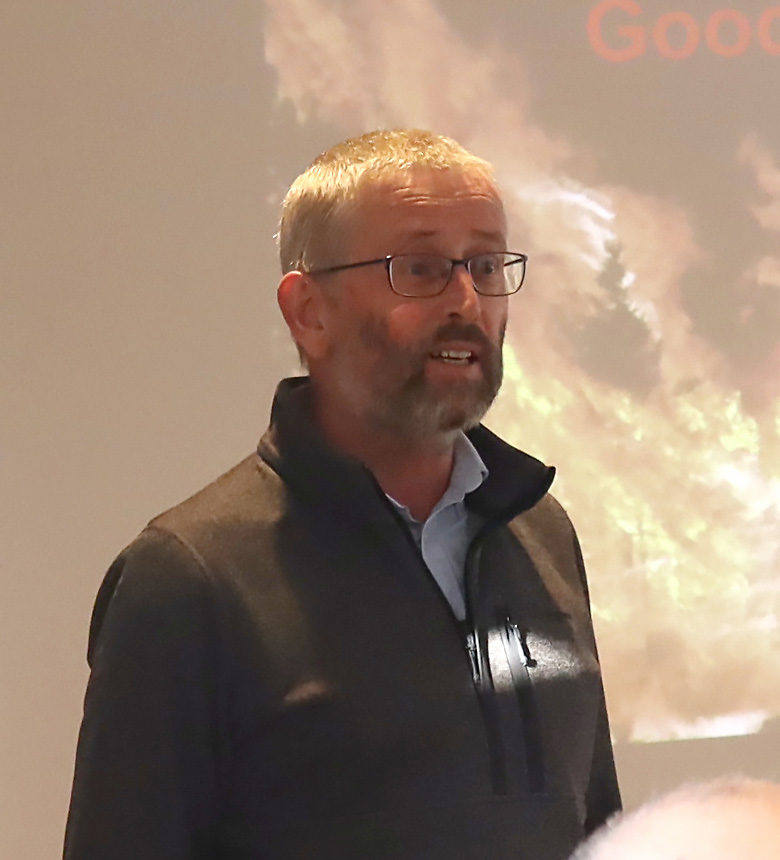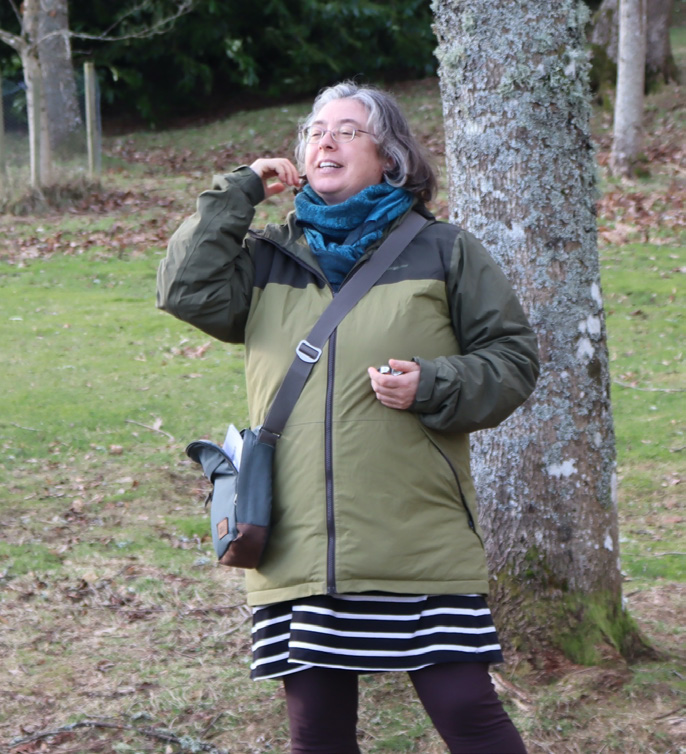Nick Porter, Scotland Editor
The winter seminar and AGM took place on Saturday 3rd February at Crathes Castle in Aberdeenshire. Branch Chair Chris Simpson welcomed attendees before introducing the morning session which featured presentations from two guest speakers.

Dr Peter Thomas

Petra Vergunst

Left to right: Vice Chair Mike Charkow, Chair Simon Stuart, Secretary Ruthe Davies.
Dr Peter Thomas is an Emeritus Reader at Keele University and an Associate of Harvard Forest at Harvard University, USA. He is well known for his book Trees: Their Natural History. Peter gave a great talk titled ‘Fires in the Forest – Good or Bad?’ He explained that the leading cause of forest fires is lightning strikes with approximately 100 strikes per second taking place at any one time across the world. He went on to talk about the adaptations trees have made to survive fire including the thick air-filled bark of Sequoiadendron giganteum protecting the cambium and the ability of Populus tremula to sprout back from the base if the top portion of the tree is destroyed. It was interesting to hear that during forest fires less than 5% of animals are thought to be killed as most will be able to escape to areas of safety. Peter concluded his talk by saying that forest fires are a natural part of the life cycle of many forests. Therefore, instead of trying to suppress them, we should look to move to a management system that prescribes smaller fires to stop the build-up of wood fuel on the forest floor, which in turn would help to avoid larger, more damaging fires.
Petra Vergunst, a field ecologist who specialises in lichens and bryophytes, has carried out extensive surveys of the forests and woodlands, the heritage landscape and the coastline of North-East Scotland where she lives. Petra gave a highly engaging talk titled ‘Lichens on Trees – Recognition and Relevance’. It began with an overview of how a lichen is a symbiotic relationship between fungi and either cyanobacteria or algae. Petra talked about the various growth forms of lichens including crustose (flat), foliose (leafy) and fruticose
(shrubby) and how these differences can be used to aid identification in the field. Lichens’ complex means of sexual and asexual reproduction and their influence on the spread and establishment of new communities were discussed. Petra described the various environmental niches that different lichens occupy with some preferring the acidic bark of conifers while others instead grow on the basic bark of broadleaves. As the talk was coming to an end, Petra gave a fascinating update that lichen may not actually just be a symbiotic relationship between a fungi and algae or cyanobacteria but instead may be a composite organism made up of these first two but also yeast and bacteria as well!
After lunch, and armed with hand lenses, we headed out to the grounds of Crathes Castle where Petra taught the group how to identify different lichens on trees including Chrysothrix candelaris and Evernia prunastri.
Petra’s passion for the subject really came through, and to engage people with this subject and help with identification of these often-overlooked organisms, she has set up www.scottishlichens.co.uk and the Scottish Lichens Facebook group.
Prizes presented
The Tom Hall Memorial Literary Prize is awarded every year in recognition of writing in the ARB Magazine that contributes to our understanding of arboriculture in Scotland. This year’s winner was Sarah Franklin who is the Landscape Manager at Historic Environment Scotland. Sarah wrote a fantastic article titled ‘Living Archaeology: The legacy of the Beauly Elm’ which featured in issue 203. The article discussed the innovative ways that were used to record and remember the culturally important Beauly Elm in its later stages of life and after it died.
The Ken Martin Memorial Award is presented to those that have made an outstanding contribution to the arboriculture industry in Scotland. This year’s recipient was Steve Milne who is an arboricultural officer for the City of Edinburgh Council. Steve received the award for his work with the Scottish Tree Officers Group.
Big congratulations to both of this year’s award winners!
AGM
Chris Simpson gave the officers’ report, which included a summary of the branch events that took place in 2023. Chris thanked the organisers of all the events, which included the very successful tree climbing competition (which is set to return again this year) and the ‘Trees and the Law in Scotland’ event with speakers Dr Charles Mynors and Elizabeth Nicholls. It was also noted that the events organised in 2023 by the Scotland Branch had made an overall profit for the Association. Chris also thanked everyone that had helped and supported him during his time as chair. Branch Secretary Struan Dalgleish reported that Association membership in Scotland stood at 160. Nick Porter, who is the editor of the ‘From the Branches: Scotland’ pages of the magazine, reported that 17 articles in total were submitted during 2023.
Branch committee members and officers for 2024 were then appointed. Simon Stuart takes over as chair and Chris Simpson stood down from the committee. Ruthe Davies takes over as secretary from Struan Dalgleish who will remain on the committee. Mike Charkow takes over as vice-chair from Alan McDowell who will also stay on the committee. Mark Foster, Matthew Cooper, Chris Knapman, Callum Braithwaite, Nick Porter and Ronnie Barker all stay on as committee members.
Before the meeting came to a close, new chair Simon Stuart took the opportunity to thank Chris, Struan and Alan for their hard work, acknowledging that over their time as chair, vice chair and secretary the Scotland Branch has put on a large number of high-quality events. We’ve been lucky to have them!
Our thanks to the speakers, Dr Peter Thomas and Petra Vergunst, and to everyone that attended this year’s winter seminar and AGM. Keep an eye on the e-Blast emails and the Association’s website for more events coming up in Scotland in 2024.
This article was taken from Issue 204 Spring 2024 of the ARB Magazine, which is available to view free to members by simply logging in to the website and viewing your profile area.